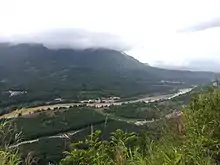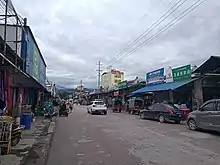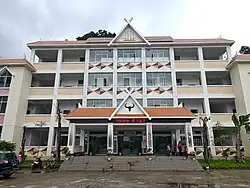Mangshi
Mangshi (Chinese: 芒市; Wade–Giles: Mangshih; Tai Nuea: ᥝᥥᥒᥰ ᥛᥫᥒᥰ ᥑᥩᥢᥴ; Jingpho: Mangshi Myu), former name Luxi (潞西),[3] is a county-level city and the seat of Dehong Dai and Jingpo Autonomous Prefecture, western Yunnan province, China. Mangshi has an area of 2,900.91 km2 (1,120.05 sq mi), with an urban area of 18.66 km2 (7.20 sq mi).[4] Han Chinese, Dai people (Tai Nuea branch) and Jingpo people (Zaiwa branch) are the major ethnic groups. Luxi County was founded in 1949, and became a county-level city in 1996.
Mangshi
芒市 | |
|---|---|
| Other transcription(s) | |
| • Pinyin | Mángshì |
| • Tai Nuea | ᥝᥥᥒᥰ ᥛᥫᥒᥰ ᥑᥩᥢᥴ |
| • Jingpho | Mangshi Myu |
| • Burmese | မန်စီ |
| • Thai | เมืองข้อน |
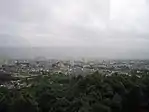 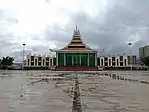 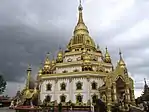   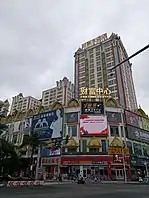 From top, left to right: Skyline of Mangshi, Mangshi Square with China-Myanmar Friendship Memorial Hall, Menghuan Pagoda, Menghuan Road upper, Mangshi Hotel, Mangshi fortune center plaza | |
| Etymology: Evolved form the ethnic name "茫施" (Mangshi) | |
| Nickname: city of dawn | |
 Territory of Mangshi (red) in Yunnan Province | |
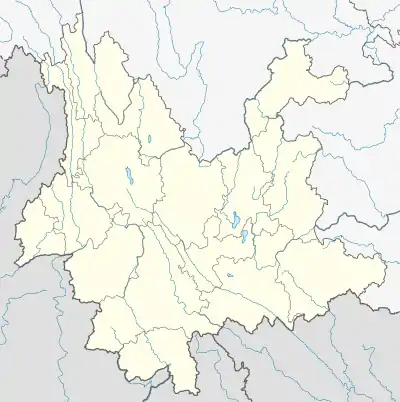 Mangshi Location in Yunnan  Mangshi Mangshi (China) | |
| Coordinates (Mangshi government): 24°26′01″N 98°35′17″E | |
| Country | China |
| Province | Yunnan |
| Autonomous Prefecture | Dehong |
| Founded | 1996 |
| Municipal seat | Menghuan Subdistrict |
| Area [1]: 536 | |
| • Total | 2,900.91 km2 (1,120.05 sq mi) |
| Elevation | 933 m (3,061 ft) |
| Population (2020 census)[2] | |
| • Total | 439,931 |
| • Density | 150/km2 (390/sq mi) |
| Time zone | UTC+8 (China Standard) |
| Postal code | 678400 |
| Phone code | (0)692 |
| Website | www |
Etymology
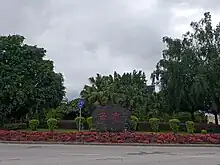
The name "Mangshi" first appeared in 1443, when the Tai Nuea tusi Mangshi Yuyi Zhangguansi (芒市御夷长官司) was established. In the history, an ethnicity named Mangshi (茫施) lived in this area. The name of "芒市" evolved from "茫施" (the pinyin are same). Luxi (潞西) is the former name of Mangshi, meaning "west of Lu [Salween] River".[5]: 460
In Tai Nuea language, the city name is Muang Khon[6]: 18 (ᥛᥫᥒᥰ ᥑᥩᥢᥴ), written in Chinese is "勐焕", meaning "city of dawn".[5]: 460
In 2008, 4,751 people participated in a public opinion survey in favour of restoring the historical name (Mangshi), with 96.96% supporting a name change to Mangshi.[3] In 2010, the name was formally changed. "Mangshi" is the proper name of the city, however, the character "市" (shì) itself means "city".[7] The full name in Chinese language is "芒市" (Mangshi), the official English translation in the Yearbook of Dehong is "Mangshi City".[8]
History
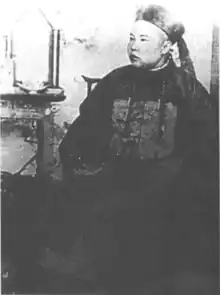

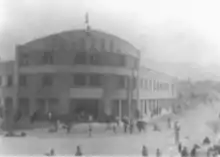
Historically, Mangshi was divided among three tusi territories. Mangshi Lu (茫施路), established by Yuan dynasty in 1276, was the first time the region was integrated into the administrative system of a Chinese dynasty. Mangshi Lu was part of Jinchi Xuanfusi (金齿等处宣抚司), Yunnan Province. In 1277, the area was affected by the first Mongol invasion of Burma. Ming dynasty repealed Mangshi Lu and set Mangshi Fu (茫施府) in 1382. Because Mangshi chief Dao Fangge (刀放革) helped the Ming dynasty army in the Luchuan–Pingmian campaigns, Ming dynasty made him the Mangshi Tusi (native chieftain), and founded the agency Mangshi Yuyi Zhangguansi (芒市御夷长官司) in 1443. In 1584, Ming dynasty created another tusi, Zhefang Fuxuanfusi (遮放副宣抚司) in Zhefang area, formerly part of Longchuan Xuanfusi (陇川宣抚司). In 1640, Mangshi Yuyi Zhangguansi upgraded to Mangshi Anfusi (芒市安抚司). In 1899, Qing dynasty set the 3rd tusi, Mengban Tuqianzong (勐板土千总) in modern Mangshi Area.[10]: 9, 20–21
In Republic of China period, the Yunnan government appointed two "suppression commissars" (彈壓委員) to Mangban (芒板) and Zhemao (遮卯) within the Mangshi area in 1913. Mangban suppression commissar administered Mangshi Anfusi and Mengban Tuqianzong territories, and Zhemao suppression commissar administered Zhefang Xuanfusi and Mengmao Anfusi (勐卯安撫司, in Ruili) territories. The two suppression commissars were replaced by an administrative commissar (行政委員) in 1915, and a district named Mangzheban Administrative District (芒遮板行政區) was established. At the same time, Mengmao Anfusi was separated from the district, thus forming the boundaries of modern Mangshi. As a transition before formally establishing a county, Yunnan government set a Shezhiju (設治局, similar to a governing council) in Mangshi area named Mangzheban Shezhiju (芒遮板設治局) replacing Mangzheban District in 1929. The Administrative Bureau is a quasi-county level administrative division. Mengga is the seat of the bureau. It changed the name to Luxi Shezhiju (潞西設治局) in 1934. Imperial Japanese Army occupied Luxi at 4 May 1942 and retreated at 11 December 1944 when Counterattack of Western Yunnan started. In 1949, Luxi Administrative Bureau finally became Luxi County (潞西县), with the seat of county government at the town of Mangshi, and the first county magistrate was the acting Tusi Fang Kesheng (方克胜). The Tusi system and the central bureaucracy still coexisted.[10]: 10–11, 21–22
Fang Kesheng refused to join People's Republic of China, preferring to remain neutral. Eventually the People's Liberation Army advanced into Luxi in April 1950, and Fang Kesheng fled to Taiwan. His brother Fang Keguang succeeded be the acting tusi, and cooperated with the Chinese Communist Party. The three tusi were killed during the land reform movement in 1955.[9]: 160 Luxi County became Luxi City (county-level city) in 1996, and changed the name to Mangshi City in 2010.[11]: 2547
Saophas
- Fang Xing Kyeng 1443-1459
- Vacant 1459-1465
- Fang Kyeng Hpa 1465-1487
- Vacant 1487-1506
- Fang Hkoe Hpa 1506-1518
- Vacant 1518-1523
- Fang Faeng Hpa 1523-1542 (kill in 1591 by Yue Feng the chief of revolt)
- Vacant 1542-1573
- Fang Fu Hpa 1573-1591 (son of Fang Faeng Hpa, killed with his father)
- Fang Wei Hpa 1592-1595 second son of Fang Faeng Hpa, object by Lui Dadao general of Ming Dynasty
- Vacant 1595-1596
- Fang Hpo Hpa 1596-1639 (son of Fang Wei Hpa)
- Vacant 1639-1640
- Fang Htiang Hpa 1640-1647 (son of Fang Hpo Hpa, kinnapped with his son name Fang Ku Chang by the burmese military in 1647 the both disappears)
- Vacant 1647-1648
- Fang Htiet Hpa 1648-1658 (son of Fang Htiang Hpa)
- Vacant 1658-1661
- Fang Kyaung Hpa 1661-1664 (son of Fang Htiet Hpa)
- Vacant 1664-1668
- Fang Tieb Hpa 1668-1673 (son of Fang Kyaung Hpa)
- Fang Meik Hpa 1673-1685 (son of Fang Kyaung Hpa)
- Fang Hkied Hpa 1685-1694 (younger brother of Fang Meik Hpa)
- Vacant 1694-1696
- Fang Htien Hpa 1696-1713 (son of Fang Meik Hpa)
- Vacant 1713-1716
- Fang Hkoen Hpa 1716-1738 (first son of Fang Htien Hpa)
- Vacant 1738-1741
- Fang Fun Hpa 1741-1770 (son of Fang Hkoen Hpa) 1st
- Vacant 1770-1771
- Fang Ngue Chang 1771-1772 (hanged to die)
- Fang Fun Hpa 1772-1774 2nd
- Fang Kyoung Hpa 1774-1796 second son of Fang Fun Hpa
- Vacant 1796-1798
- Fang Hso Hpa 1798-1816 son of Fang Kyoung Hpa
- Fang Xing Hpa 1816-1821 killed by the revolt
- Fang Hso Hkao 1821-1826 cousin of Fang Xing Hpa
- Fang Earn Hpa 1826-1849 first son of Fang Xing Hpa
- Fang Chuen Hpa 1849-1858 younger brother of Fang Earn Hpa
- Vacant 1858-1875
- Fang Lu Hpa 1875-1877 first son of Fang Chuen Hpa
- Vacant 1877-1879
- Fang Chow Hpa 1879-1889 younger brother of Fang Chuen Hpa
- Fang Yong Hpa 1889-1889 younger brother of Fang Chow Hpa
- Fang Kyoet Hpa 1889-1910 son of Fang Lu Hpa
- Fang Hkoeng Hpa 1910-1931 son of Fang Kyoet Hpa
- Vacant 1931-1933
- Fang Yuan Hpa 1933-1936 son of Fang Hkoeng Hpa
- Fang Hkue Kawng 1936-1953 third son of Fang Kyoet Hpa
- Fang Hkue Chang 1944-1948 fourth son of Fang Kyoet Hpa (became saopha of Mongmao)
- Fang Luang Hpa 1948-1955 (became saopha with Fang Hwe Lung during 1953-1955) fifth son of Fang Hkoeng Hpa
- Fang Hwe Luang 1953-1955 (last saopha) younger brother of Fang Luang Hpa
Geography
Mangshi has an area of 2,900.91 km2 (1,120.05 sq mi). There are two main plains in Mangshi named Mangshi Ba (芒市坝) and Zhefang Ba (遮放坝). The city of Mangshi is situated at the east of Mangshi Ba. Mountains are the primary landforms of Mangshi, making up approximately 84.48% of the territory. Mount Qingkou (箐口山) is the city's highest point, with an altitude of 2,889.1 meters. Manxin River's (曼辛河) estuary (at Salween River) is the lowest point, with an altitude of 528 metres in Zhongshan Township.[10]: 52–53 The mountains are branches of western Gaoligong Mountains.[12]: 40
Mangshi River is the "mother river" of Mangshi,[13] and has a drainage basin of 1,881 km2 (726 sq mi),[14]: 90–91 about 61.3% of area of Mangshi. Longchuan River (龙川江) is the border river between Mangshi and Lianghe County and Longchuan County on the north and west. Salween River on the southeast tip of Mangshi marks the international border between Mangshi and Myanmar's Shan State.[10]: 59 [5]: 185
Climate
| Climate data for Mangshi (1991–2020 normals, extremes 1981–2010) | |||||||||||||
|---|---|---|---|---|---|---|---|---|---|---|---|---|---|
| Month | Jan | Feb | Mar | Apr | May | Jun | Jul | Aug | Sep | Oct | Nov | Dec | Year |
| Record high °C (°F) | 27.0 (80.6) |
31.0 (87.8) |
33.4 (92.1) |
35.2 (95.4) |
35.6 (96.1) |
34.9 (94.8) |
34.4 (93.9) |
35.3 (95.5) |
35.0 (95.0) |
33.4 (92.1) |
29.7 (85.5) |
27.4 (81.3) |
35.6 (96.1) |
| Average high °C (°F) | 22.2 (72.0) |
24.4 (75.9) |
27.7 (81.9) |
29.7 (85.5) |
29.8 (85.6) |
29.0 (84.2) |
28.3 (82.9) |
29.2 (84.6) |
29.5 (85.1) |
28.0 (82.4) |
25.5 (77.9) |
22.8 (73.0) |
27.2 (80.9) |
| Daily mean °C (°F) | 13.1 (55.6) |
15.1 (59.2) |
18.4 (65.1) |
21.5 (70.7) |
23.6 (74.5) |
24.4 (75.9) |
24.1 (75.4) |
24.5 (76.1) |
24.0 (75.2) |
21.9 (71.4) |
17.8 (64.0) |
14.2 (57.6) |
20.2 (68.4) |
| Average low °C (°F) | 6.9 (44.4) |
8.3 (46.9) |
11.4 (52.5) |
15.2 (59.4) |
19.2 (66.6) |
21.6 (70.9) |
21.8 (71.2) |
21.8 (71.2) |
20.9 (69.6) |
18.3 (64.9) |
13.0 (55.4) |
8.9 (48.0) |
15.6 (60.1) |
| Record low °C (°F) | −0.2 (31.6) |
1.5 (34.7) |
3.6 (38.5) |
7.5 (45.5) |
13.2 (55.8) |
16.8 (62.2) |
15.9 (60.6) |
17.6 (63.7) |
14.5 (58.1) |
9.3 (48.7) |
5.5 (41.9) |
1.0 (33.8) |
−0.2 (31.6) |
| Average precipitation mm (inches) | 19.9 (0.78) |
19.6 (0.77) |
26.5 (1.04) |
65.4 (2.57) |
147.2 (5.80) |
267.2 (10.52) |
371.9 (14.64) |
339.0 (13.35) |
170.3 (6.70) |
131.6 (5.18) |
38.3 (1.51) |
9.7 (0.38) |
1,606.6 (63.24) |
| Average precipitation days (≥ 0.1 mm) | 3.2 | 4.0 | 5.8 | 10.6 | 16.2 | 23.3 | 27.8 | 25.1 | 19.0 | 13.4 | 5.5 | 2.6 | 156.5 |
| Average relative humidity (%) | 76 | 70 | 64 | 66 | 73 | 83 | 87 | 85 | 83 | 81 | 79 | 79 | 77 |
| Mean monthly sunshine hours | 227.9 | 217.8 | 228.8 | 211.8 | 190.3 | 111.8 | 79.4 | 111.9 | 140.1 | 169.3 | 209.9 | 220.1 | 2,119.1 |
| Percent possible sunshine | 68 | 68 | 61 | 55 | 46 | 27 | 19 | 28 | 38 | 48 | 64 | 67 | 49 |
| Source: China Meteorological Administration[15][16] | |||||||||||||
Administrative divisions
Mangshi currently comprises 12 administrative township-level subdivisions including one subdistrict, five towns and six townships.[17]
| Name | Name in Chinese |
Code[18] | Founded [5]: 459–495 |
Area (km2) [11]: 2552–2572 |
Population 2010 Census[19] |
Density |
|---|---|---|---|---|---|---|
| Menghuan Subdistrict | 勐焕街道 | 533103001 | 2008 | 23.15 | 99,970 | 4318.36 |
| Mangshi Town | 芒市镇 | 533103101 | 1936 | 349.5 | 46,353 | 132.63 |
| Zhefang Town | 遮放镇 | 533103102 | 1936 | 422 | 51,477 | 121.98 |
| Mengga Town | 勐戛镇 | 533103103 | 1936 | 389 | 24,344 | 62.58 |
| Manghai Town | 芒海镇 | 533103104 | 1988 | 105 | 5,641 | 53.72 |
| Fengping Town | 风平镇 | 533103105 | 1998 | 381 | 69,586 | 182.64 |
| Xuangang Township | 轩岗乡 | 533103201 | 1936 | 163.7 | 21,501 | 131.34 |
| Jiangdong Township | 江东乡 | 533103202 | 1988 | 220.8 | 25,240 | 114.31 |
| Xishan Township | 西山乡 | 533103203 | 1988 | 257 | 12,296 | 47.84 |
| Zhongshan Township | 中山乡 | 533103204 | 1988 | 278 | 10,170 | 36.58 |
| Santaishan Palaung Ethnic Township | 三台山德昂族乡 | 533103205 | 1988 | 158 | 7,068 | 44.73 |
| Wuchalu Township | 五岔路乡 | 533103206 | 1988 | 202 | 16,245 | 80.42 |
Economy
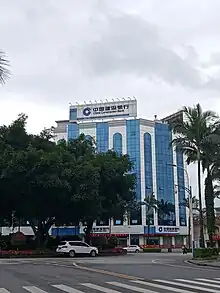
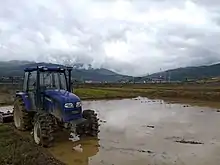
As of 2016, Mangshi nominal GDP was CN¥ 9.628 billion, about 0.65% of the province's GDP, ranking 44th among county-level administrative units in Yunnan; its nominal GDP per capita was CN¥ 23,307, 66th in the province, lower than Yunnan average (CN¥ 30,949).[1]: 522, 524
In 1958, Yunnan government regulated trade in border areas, and the town of Mangshi was excluded from the zone of border trade.[20]: 211 In 1980, province government opened Manghai (芒海), Mangbing (芒丙) and Xiaogai (小街) as border trade markets.[20]: 201 After Hu Yaobang, the General Secretary of the Chinese Communist Party inspected Dehong prefecture in 1985, Mangshi abolished all border checkpoints, and made the whole territory a border trade zone.[21]: 645 The border trade and other tertiary sectors was prosperous in the 1990s. The proportion of three industrial sectors in 1978 was 65.6 : 16.3 : 18.1,[21]: 647 and in 2016, 23.2 : 20.5 : 56.3.[1]: 524
Asian rice, sugarcane, tea, coffee, macadamia nut and fruits (banana, pineapple, mango, jackfruit etc.) are the main agricultural products of Mangshi, especially coffee. Mangshi has 19,056 ha. of paddy field, 9,165 ha. of sugarcane field, 7,504 ha. of macadamia forest, 5,870 ha. of coffee field and 5,469 ha. of fruit field in 2018.[22] Asian Coffee Association was established at Mangshi in 2017.[23] 13 countries are members of the association.[24] Hogood Coffee is the largest domestic instant coffee producer in China,[25] and the 10th largest civilian-run enterprise of Yunnan.[26]
Population
| Year | Pop. | ±% p.a. |
|---|---|---|
| 1919 | 49,105 | — |
| 1932 | 39,618 | −1.64% |
| 1947 | 50,832 | +1.68% |
| 1953 | 109,718 | +13.68% |
| 1964 | 152,763 | +3.05% |
| 1982 | 244,411 | +2.65% |
| 1990 | 292,183 | +2.26% |
| 2000 | 337,406 | +1.45% |
| 2010 | 389,891 | +1.46% |
| Source: Annals of Luxi County etc.[10]: 40–41 [27][28]: 6 | ||
In 2016, Mangshi had a total population of 415,700 over the whole county-level city,[1]: 533 of which 171.2 thousand resided in the city core, the subdistrict of Menghuan.[29]
According to the 2010 census, Mangshi has 204,083 Han citizens, 52.34% of total population. Other main ethnicities are Dai and Jingpo, which has a population with 132,421 and 29,208.[28]: 101–121 Mangshi has the largest number of Palaung people in any county-level subdivision of China, with a population of 9,986,[28]: 101–121 which mainly live in Santaishan Palaung Ethnic Township.[Note 1][10]: 39
Historically, Dai people lived in the plains.[10]: 420 Jingpo people immigrated to the mountains from the Tibetan Plateau in the 16th century.[10]: 425 Han Chinese became the majority because of the Ming conquest of Yunnan and several Sino-Burmese wars, and the subsequent stationing of Chinese army in the area.[5]: 227
Culture
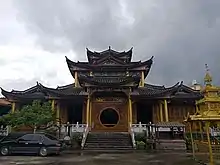
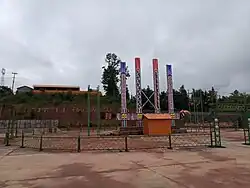
Dai people in Mangshi speak Tai Nuea language,[10]: 420 while Jingpo people speak Zaiwa and Jingpho. Zaiwa is the most populous branch of Jingpo in Mangshi.[10]: 426
Almost all the Dai and Palaung people follows Theravada Buddhism. Many villages have their own Buddhist temple,[10]: 422 called "Zhuangfang" (奘房) or "Miansi" (缅寺; 'Burmese temple'). They are the center for religion activities and education, and also the entertainment venues for villagers.[30]: 154, 156 Expenditure of the temple and the monk life costs are paid by the villagers. An average Dai farmer spends one-fifth of his annual income for religion-related activities in 1988.[10]: 422 In Jingpo folk religion, various gods as well as ancestral spirits are worshipped.[10]: 451
Water-Sprinkling Festival (in Thailand called "Songkran") and Manau are the grandest festivals of the Dai and Jingpo. They are both statutory holidays in Dehong Prefecture.[31] The 15,000-capacity Dehong Stadium, a football stadium, is also used for cultural events.
Transport

Tusi Fang Keming (方克明) of Mangshi and Duo Jianxun (多建勋) of Zhefang built a road linking Mangshi and Wanding in 1926. An Indian engineer was invited to design the route. The road was completed in 1931, and became a part of the Burma Road in 1937.[10]: 152 In modern China National Highways network, this road is part of G320 Highway.[32]: 42 Longling-Ruili Expressway opened on 31 December 2015, and is the first expressway of Mangshi. It forms part of G56 Hangzhou–Ruili Expressway and AH14.[33] A provincial highway, Mangshi-Lianghe Expressway is currently under construction.[34] Another provincial expressway, Ruili-Menglian Expressway, is planned.[35]
Although Mangshi has a 68.23 km-long borderline with Myanmar, it has no national port of entry. There are three border crossing without customs control into Myanmar serving the locals. They are Manghai (芒海), Zhongshan (中山) and Bangda (邦达).[36]: 162 Manghai links Mong Ko in Myanmar, also known as Monekoe.
Dali–Ruili railway is under construction, with two stations in Mangshi: Mangshi and Mangshi West.[37]
Dehong Mangshi International Airport is the only airport in Dehong Prefecture. It saw 1,652,533 passengers and 13,982 flights in 2017.[38]
Society
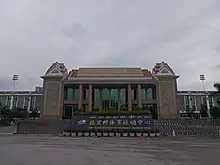

Dehong Sports Center is located on the west of Mangshi, with a 21,000-capacity stadium, a 3,200-capacity basketball gym, a 2,150-capacity aquatics center, a 6-courts tennis gym and other outdoor sports fields. The sports center was built in 2008, and has a building area of 36,813.49m2.[39]
Dehong People's Hospital is a Tertiary B-level hospital established in 1954 in southeast of Mangshi.[21]: 551 It has 1,200 beds and the service area covered up Dehong, Longling, Tengchong and part of Myanmar.[40]
Dehong Teachers' College (德宏师范高等专科学校) is the main higher education college of Dehong, established in 2006.[21]: 491 It is a technical college but under the working for upgrade to an undergraduate education university.[41] Many Burmese students are studying abroad in the college.[42]
Dehong's media is multilingual, reflecting its diverse ethnic makeup. Dehong TV Station was established in 1991, with programs in Chinese, Tai Nuea, Jingpho and Zaiwa. Dehong TV Station is the only TV station that uses four languages in China.[21]: 522 Dehong Unity News (德宏团结报) is the official newspaper of Dehong Prefecture Committee of the Chinese Communist Party. The newspaper using five languages: Chinese, Tai Nuea, Jingpho, Zaiwa and Lisu. It is the only newspaper that uses five languages in China.[21]: 518 Pauk-Phaw, the first Burmese newspaper of China, was founded in Mangshi in 2015 and is published by Dehong Unity Newspaper office. It serves the 50,000 Burmese who live in China.[43]
Tourism
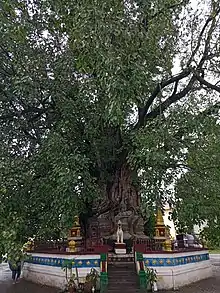

3.3 million tourists visited Mangshi in 2015, and generated a tourism income of CN¥ 5.09 billion for the city.[4] Puti Temple,[44] Wuyun Temple and Foguang Temple are well known Buddhist temples in Mangshi.[30]: 155 Tiecheng Pagoda, Fengping Pagoda and Menghuan Pagoda are well known Buddhist pagodas.[10]: 462 Tiecheng Pagoda, also known as "Shubao Pagoda" (Chinese: 树包塔; lit. 'pagoda wrapped by tree'), was built in Qianlong era, Qing dynasty. A seed fell in the crack of the pagoda about 200 years ago, and now, the pagoda is wrapped by the bodhi tree.[45]: 262 [30]: 53 Mengbanaxi Exotics Garden, a garden for valuable ancient trees and tree fossils, is the only AAAA state-level tourist destination of Mangshi.[46]
Friendly cities
Mangshi currently maintains friendship agreements with the following foreign
 Gangneung, Gangwon-do, South Korea[47]
Gangneung, Gangwon-do, South Korea[47]
Notes
- Other major area of Palaung people in China: Zhenkang County (2,374), Ruili City (1,783), Longchuan County (1,454), Gengma County (1,158), Longyang District (1,075)
References
- Li Cheng (李赪) (2012). 《云南统计年鉴2017》 [Statistical Yearbook of Yunnan 2017] (in Chinese). Beijing: China Statistics Press. ISBN 978-7-5037-8267-1.
- "德宏州第七次全国人口普查主要数据公报" (in Chinese). Government of Dehong Prefecture. 11 June 2021.
- 国务院正式批复同意潞西更名为芒市 (in Chinese). Yunnan Xinhua. 23 July 2010. Archived from the original on 25 July 2010. Retrieved 4 December 2010.
- 芒市市情概况 [Overview of Mangshi]. www.dhms.gov.cn (in Chinese). Mangshi government. 29 June 2016. Retrieved 3 August 2018.
- 德宏傣族景颇族自治州志编纂委员会 (1994). 《德宏州志·综合卷》 [Annals of Dehong Prefecture · Integrated Volume] (in Chinese). Mangshi: Dehong Nationalities Publishing House. ISBN 7-8052-5248-3.
- Yos Santasombat (2008). Lak Chang: A reconstruction of Tai identity in Daikong. Canberra: ANU Press. ISBN 978-1740760812.
- Wei Yinxia (魏银霞) (28 September 2010). 云南省德宏州州府潞西市正式更名为"芒市" [Luxi ,the capital of Dehong Prefecture in Yunnan, official name change to Mangshi]. 孔雀之乡网 (in Chinese). Mangshi. Retrieved 24 July 2018.
- 德宏傣族景颇族自治州志编纂委员会 (2017). 《德宏年鉴2017》 [Yearbook of Dehong 2017] (in Chinese). Mangshi: Dehong Nationalities Publishing House. p. English Contents page1. ISBN 978-7-5558-0726-1.
- 德宏州政协文史和学习委 (1997). 《德宏州文史资料选辑 第十辑(德宏土司专辑)》 [Compilation of History Reference of Dehong Prefecture - 10th volume (Dehong Tusi volume)] (in Chinese). Mangshi: Dehong Nationalities Publishing House. ISBN 7-80525-340-4.
- 云南省潞西县志编纂委员会 (1993). 《潞西县志》 [Annals of Luxi County] (in Chinese). Kunming: Yunnan Education Publishing House. ISBN 7-5415-0685-0.
- Ministry of Civil Affairs (2016). 《中华人民共和国政区大典 云南卷》 [People's Republic of China Administrative Divisions Encyclopedia Yunnan Volume] (in Chinese). Beijing: China Social Publisher. ISBN 978-7-5087-5306-5.
- 中共云南省委政策研究室; 云南省志编纂委员会办公室 (1986). 《云南地州市县概况 德宏傣族景颇族自治州分册》 [Overview of Prefecture, city and county of Yunnan·Dehong Dai and Jingpo Autonomous Prefecture Volume] (in Simplified Chinese).
- "Mangshi River". en.dehong.gov.cn. Dehong.Gov. 24 September 2013. Retrieved 21 May 2018.
- Jing Zhengshu (敬正书) (2010). 《中国河湖大典 西南诸河卷》 [China Rivers and Lakes Encyclopedia]. Beijing: China Water&Power Press. ISBN 978-7-5170-2699-0.
- 中国气象数据网 – WeatherBk Data (in Simplified Chinese). China Meteorological Administration. Retrieved 9 April 2023.
- 中国气象数据网 (in Simplified Chinese). China Meteorological Administration. Retrieved 9 April 2023.
- "国家统计局" (in Chinese). National Bureau of Statistics of the People's Republic of China. Retrieved 7 December 2021.
- 2017年统计用区划代码和城乡划分代码(截止2017年10月31日)>>533103000 芒市 [Administrative division codes of the People's Republic of China, 2017 >> 533103000 Mangshi] (in Chinese). National Bureau of Statistics of China. Retrieved 27 July 2018.
- 国务院人口普查办公室; 国家统计局人口和就业统计司 (2012). 《中国人口普查分乡、镇、街道资料》 [Townships, Towns and Subdistricts Reference of China Census]. Beijing: China Statistics Press. ISBN 978-7-5037-6660-2.
- 德宏史志编纂委员会 (1997). 《德宏州志·经济卷》 [Annals of Dehong Prefecture · Economy Volume]. Mangshi: Dehong Nationalities Publishing House. ISBN 7-80525-398-6.
- 《德宏改革开放30年》编委会 (2008). 《德宏改革开放30年》 [30 Years of Dehong since Economic Reform]. Mangshi: Dehong Nationalities Publishing House. ISBN 978-7-80750-133-6.
- Liu Xiangyuan (刘祥元) (29 March 2018). 芒市加大招商引资力度 [Mangshi Increase Investment Working]. yndaily.yunnan.cn 云南日报 (in Chinese). Retrieved 2 August 2018.
- "The Asian Coffee Association established in Mangshi". en.dehong.gov.cn. Dehong Government. 4 December 2017. Retrieved 2 August 2018.
- "Vietnam joins management board of Asian Coffee Association". english.vov.vn. THE VOICE OF VIETNAM ONLINE. 28 November 2017. Retrieved 2 August 2018.
- "Case Study" (PDF).
- Zhao Gang (赵岗) (2 August 2018). 入围门槛7.45亿 2018云南非公企业百强公布 俊发集团471亿排第一 [Finalist threshold is 745 million Chinese yuan, list of 100 largest civilian-run enterprises of Yunnan 2018 has published, Junfa Group is the top 1 with 47.1 billion worth]. yn.yunnan.cn 云南网 (in Chinese). Retrieved 2 August 2018.
- 表1 总人口、户籍人口、少数民族人口比重、非农业户口人口比重、城乡人口、家庭户人口、家庭户类别(全部数据). www.dhms.gov.cn (in Chinese (China)). National Bureau of Statistics of China. Retrieved 13 May 2020.
- Luo Jinzhong (罗进忠) (2012). 《云南省2010年人口普查资料》 [People Census Reference of Yunnan 2010] (in Chinese). Beijing: China Statistics Press. ISBN 978-7-5037-6548-3.
- 勐焕街道概况 [Overview of Menghuan Subdistrict]. www.dhms.gov.cn (in Chinese). Mangshi government. 26 March 2018. Retrieved 3 August 2018.
- Zhang Fangyuan (张方元) (2000). 《新编德宏风物志》 [Annals of Dehong Prefecture · Economy Volume]. Kunming: Yunnan People's Publishing House. ISBN 7-222-02968-0.
- 我国普遍法定节假日有7个,而这些少数民族的节假日却不止 [There are 7 statutory holidays in China, but in minority area are more than 7]. 雪花新闻 (in Chinese). 17 March 2018. Retrieved 3 August 2018.
- 德宏傣族景颇族自治州交通局 (1999). 《德宏州交通志》 [Annals of Transportation of Dehong Prefecture]. Kunming: Yunnan National Publisher. ISBN 7-5367-1188-3.
- Liu Xiangyuan (刘祥元); Wang Yunrui (王云瑞) (1 January 2016). 龙瑞高速全线建成通车 昆明到瑞丽实现全程高速 [Longling-Ruili Expressway opened the whole of line, Kunming to Ruili realized entire journey with expressway]. www.yndaily.com (in Chinese). Yunnan Daily Newspaper. Retrieved 28 July 2018.
- Cui Wen (崔汶) (30 March 2017). 中缅边境芒市至梁河高速公路开建 [China-Myanmar border Mangshi-Lianghe Expressway started construction]. www.chinanews.com (in Chinese). China News Service. Retrieved 28 July 2018.
- Wang Lei (王磊) (5 December 2017). 瑞丽至孟连将建高速 [China-Myanmar border Mangshi-Lianghe Expressway started construction]. xw.kunming.cn 春城晚报 (in Chinese). Retrieved 28 July 2018.
- Yang Hong (2015). 滇西边境县研究书系 芒市 (in Chinese (China)). Kunming: Yunnan University Press. ISBN 978-7-5482-2412-9.
- 全面推进|大瑞铁路德宏段建设呈现出大工地、大建设态势 [Construction of Dali–Ruili railway Dehong part showing the big construction situation] (in Chinese (China)). Dehong Prefecture People's Government. 19 March 2018. Retrieved 28 July 2018.
- 2017年1-12月 西南地区机场生产统计简报 [Production Statistics Briefing of Airports in Southwest China during January to December in 2017]. info.swcaac.gov.cn (in Chinese). Civil Aviation Administration of China. 31 January 2018. Archived from the original on 17 September 2017. Retrieved 28 July 2018.
- 德宏州体育运动中心——运动休闲的乐园 [Dehong Sports Center, the paradise of sports and leisure]. www.sohu.com (in Chinese). Sports Dehong. 18 April 2018. Retrieved 3 August 2018.
- 医院概况 [Overview of Hospital]. www.dhzyy.com (in Chinese). Dehong People's Hospital. Retrieved 3 August 2018.
- 全国政协会上的德宏声音 [Dehong Voice on the CPPCC]. www.dehongzx.com (in Chinese). Dehong People's PCC. 12 March 2018. Retrieved 3 August 2018.
- 缅甸留学生董明军:我想考中国的大学,学更多的农业知识 [Myanmar international student Dong Mingjun: I want go to university in China, and learn more agricultural technology]. www.dehong.gov.cn (in Chinese). Dehong Prefecture People's Government. 27 April 2018. Retrieved 3 August 2018.
- Yao Bing (姚兵) (6 December 2015). 中国首份缅文报纸《胞波》在云南德宏创刊 [First Burmese Newspaper Pauk-Phaw has founded in Dehong, Yunnan]. Xinhua News Agency (in Chinese). Archived from the original on 4 August 2018. Retrieved 4 August 2018.
- Zi Yan (2012). Famous Temples in China (in English and Chinese). Hefei, Anhui: Huangshan Publishing House. pp. 171–172. ISBN 978-7-5461-3146-7.
- 《德宏傣族景颇族自治州概况》编写组 (2008). 《德宏傣族景颇族自治州概况》 [Overview of Dehong Dai and Jingpo Autonomous Prefecture]. Beijing: Publishing House of Minority Nationalities. ISBN 978-7-10508-592-7.
- "Mengbanaxi Exotic Garden Travel Guide". Discover China Tours. Retrieved 4 August 2018.
- 韩国江陵市议会代表团到芒市进行友好交流 [Mission of Gangneung City Council conduct friendly exchanges in Mangshi]. www.ynmsrd.com (in Chinese). 芒市人大常委会. 19 October 2014. Retrieved 29 July 2018.
